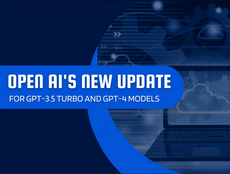Since the release of ChatGPT, OpenAI’s application programming interface (API) has become a highly sought-after resource for software engineers. OpenAI’s success has served as an example for other businesses, and as a result, more and more applications have been developed utilizing the company’s APIs.
And in response to the increased demand, Open AI has recently unveiled a series of updates to its API. These include enhanced function calling capabilities and more controllable iterations of GPT-4 and GPT-3.5 Turbo. Additionally, a new 16k context version of GPT-3.5 Turbo has been introduced, and the Embeddings model is now offering a 75% reduction in cost.

These changes are expected to result in reduced expenses for developers who utilize the API.
Let’s check out what enhancements have been made by OpenAI in its new update.
Open AI Update: Improvements In GPT-3.5 Turbo And GPT-4
The following are the most recent updates to the GPT-3.5 Turbo and GPT-4 models that OpenAI announced. These changes enhance steerability, extend context for GPT-3.5 Turbo, and reduce prices, among other enhancements.
1. Enhanced GPT Models
This new Open AI update improved the new GPT-4 and GPT-3.5 Turbo versions. They will now have enhanced context and better steerability.
As a result of enhanced steerability, developers might create AI applications that better fit the needs of a certain company or job, such as producing more focused business reports or designing better, context-aware replies in customer care chatbots.
With the release of GPT-3.5 Turbo-16k, users may request up to 20 pages of text at once, four times as much as the standard GPT-3.5 Turbo. The AI can now understand and respond to significantly larger amounts of text because of its expanded context capabilities.
2. Function Calling Capability
Developers may now describe functions to the updated models in OpenAI, and the AI will automatically generate a JSON object containing arguments for those functions, a capability that was added in response to developer feedback and requests for more capabilities.
The improved connectivity between GPT and third-party tools and APIs allows more organized data to be retrieved from the model.
Various uses, such as the ones listed below, are made possible by the newly available function calling capabilities.
- Creating chatbots that use third-party services to respond to users’ queries.
- The new API parameters allow programmers to specify functions to the model and ask it to call a certain function if desired.
- Information extraction from unstructured text.
With the advent of function calls, programmers now have more options. They have a smoother path to incorporating the GPT models with third-party APIs and tools.
3. Price Reductions
OpenAI took the welcoming step for developers. As a result of increased system efficiency, OpenAI can pass on savings to its developer community.
Text-embedding-ada-002, one of the most widely-used embedding models, has had its price cut by 75%. The GPT-3.5 Turbo variant further has a 25% decrease in input token costs.
Reduced costs and enhanced features should make it simpler for programmers to incorporate these models into their work.
Open AI Driven Applications
The latest enhancements to OpenAI’s GPT models will benefit developers and other AI enthusiasts. As a user, it’s highly probable that you’ve utilized a tool that integrates cutting-edge AI innovations from OpenAI.
1. Microsoft, as a part of its partnership with OpenAI, is providing access to AI models for programmers and incorporating generative AI into existing products like Bing and Office.
2. Snapchat’s My AI chatbot, which employs generative AI, was released utilizing OpenAI GPT models. The newest version of my AI can now send and interpret pictures.
3. The Einstein GPT CRM solution from Salesforce is the first of its kind, and it is driven by OpenAI’s “advanced models.”
4. Stripe implemented OpenAI GPT to understand users better and cut down on fraud.
5. Since GitHub Copilot used the OpenAI Codex to implement generative AI on their platform to aid developers, a conflict over copyright has arisen.
6. HubSpot used OpenAI GPT-4 to create new solutions like ChatSpot.ai.
7. Instacart developed an AI chatbot to answer their customer’s grocery-related queries.
8. Morgan Stanley is one of the very few financial management firms that have access to OpenAI’s cutting-edge GPT-4 model, and so they’ve established a collaboration with the AI company.
9. GetResponse has released an automated email service driven by OpenAI’s GPT.
It’s truly remarkable how OpenAI consistently prioritizes data privacy and security in all its model updates.
They understand the importance of ensuring that customers retain ownership of the outputs generated from their requests, and they take great care to ensure that their API data is never utilized for training purposes.
Well, let’s see what the next Open AI update will be; till then, play with it..!!

